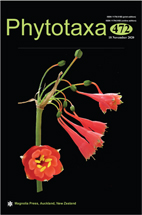Abstract
Fuscoporia caymanensis sp. nov. is described from tropical America. It is characterized by perennial, extensive, resupinate to indistinctly effused-reflexed basidiomata; a very thin to almost absent subiculum; multi-layered tubes with a black line between each layer; a dimitic hyphal system with skeletal hyphae occasionally septate; absence of mycelial setae and cystidioles; abundant hymenial setae, 40–55 × 5–7 μm; urniform basidia, and cylindrical basidiospores 4.5–5 × 2–2.4 µm. It was found growing on fallen rotten angiosperm trunks in tropical America. Phylogenetically, it is related to Fuscoporia viticola and F. palomari, but the latter two species have longer basidiospores (7–9 × 1.5–2 µm in F. viticola and 8–10 × 2.7–3.5 μm in F. palomari), and occur in temperate regions.

